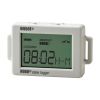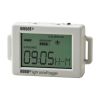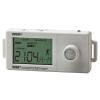Onset HOBO UX90 Motor On/Off Data Logger
The Onset HOBO UX90 motor on/off data logger records conditions within an AC magnetic field using an internal sensor, or mechanical dry contact closures from external sensing devices.
Features
- Ideal for tracking usage and runtimes of motors, pumps and compressors.
- Available in 128 KB and 512KB memory models
- Expedited repair and warranty service
- Lifetime technical support
- More
Overview
The Onset HOBO UX90 motor on/off logger records motor on/off conditions within an AC magnetic field with its internal sensor, or mechanical dry contact closures from external sensing devices. Ideal for tracking the usage and runtimes of motors, pumps, compressors, and other equipment, this logger is available in a standard 128 KB memory model (UX90-004) capable of 84,650 measurements and an expanded 512KB memory version (UX90-004M) capable of over 346,795 measurements.
| Internal Motor Sensor | |
| AC Magnetic Field Threshold |
>40 mGauss at 60 Hz |
| External Input | |
| External Contact Input |
Electronic solid state switch closure or logic driven voltage output |
| Range |
0 to 3 V DC (USB powered), 0 to 2.5 V DC (battery powered) |
| Maximum State and Runtime Frequency |
1 Hz |
| Solid State Switch Closure |
Input Low: < 10 KΩ; Input High: > 500 KΩ |
| Internal Weak Pull-Up |
100 KΩ |
| Input Impedance |
Solid state switch closure: 100 KΩ pull up |
| Logger | |
| Resolution |
Pulse: 1 pulse, Runtime: 1 second, State and Event: 1 State or Event |
| Memory Modes |
Wrap when full or stop when full |
| Start Modes |
Immediate, push button, date & time, or next interval |
| Stop Modes |
When memory full, push button, or date & time |
| Power Source |
One 3V CR2032 lithium battery and USB cable |
| Battery Life |
1 year, typical with logging intervals greater than 1 minute and normally open contacts |
| Memory |
UX90-004: 128 KB (84,650 measurements, maximum) UX90-004M: 512 KB (346,795 measurements, maximum) |
| Download Type |
USB 2.0 interface |
| Full Memory Download Time |
10 seconds for 128 KB; 30 seconds for 512 KB |
| Logger Operating Range |
Logging: -20° to 70°C (-4° to 158°F); 0 to 95% RH (non-condensing) Launch/Readout: 0° to 50°C (32° to 122°F) per USB specification |
| LCD |
LCD is visible from: 0° to 50°C (32° to 122°F); the LCD may react slowly or go blank in temperatures outside this range |
| Size |
3.66 x 8.48 x 1.52 cm (1.44 x 3.34 x 0.6 in.)
|
| Weight |
30 g (1.06 oz)
|
| Environmental Rating |
IP50 |
- HOBO UX90-004x Motor On/Off Data Logger
- Command strip
- Double-sided tape
- Hook & loop strap
In The News
Save our Bogs! Culture, Conservation and Climate Action in Ireland’s Peatlands
Characterized by long-term accumulation under waterlogged conditions, peatlands exist on every continent and account for 3-4% of the global land surface . Small but mighty, these often overlooked wetland environments are estimated to hold as much as one-third of the world's organic carbon in their soil—twice the amount found in the entirety of the Earth's forest biomass. While healthy peatlands can trap and store carbon, regulate water, and provide important habitats for rare species, human alteration has disturbed peatland carbon and nitrogen cycles on a global scale. Approximately 12% of the world’s peatlands have been drained and degraded through conversion for agriculture, forestry, infrastructure development, and other uses.
Read MoreSargassum Surge: How Seaweed is Transforming our Oceans and Coastal Ecosystems
Until recently, Sargassum –a free-floating seaweed–was distributed throughout the Sargasso Sea , the north Caribbean Sea, and the Gulf of Mexico. But in the space of a decade, this seaweed has, as one scientist remarks , “Gone from a nonfactor to the source of a terrible crisis.” Driven by climate change, anomalous North Atlantic Oscillation in 2009-2010 and a glut of anthropogenic pollutants, sargassum has proliferated. Seasonally recurrent mats as deep as 7m now bloom in the “Great Atlantic Sargassum Belt” (GASB), which covers areas of the Atlantic from West Africa to the Caribbean Sea and Gulf of Mexico. Every year, millions of tons wash up along the shores of more than 30 countries . Dr.
Read MoreGreat Lakes Research Center: Designing Targeted Monitoring Solutions
According to the National Oceanic and Atmospheric Administration ( NOAA ), the Great Lakes have more miles of coastline than the contiguous Atlantic and Pacific coasts combined and contain 20 percent of the world's freshwater, making it a critical region to protect and conserve. Continuous monitoring and data-informed resource management are key components of managing waters in the region. Hayden Henderson, a research engineer with the Great Lakes Research Center (GLRC), designs and deploys monitoring platforms throughout the Great Lakes. With a background in environmental engineering, Henderson enjoyed the challenge of creating systems and making them work to obtain difficult, remote measurements.
Read More














